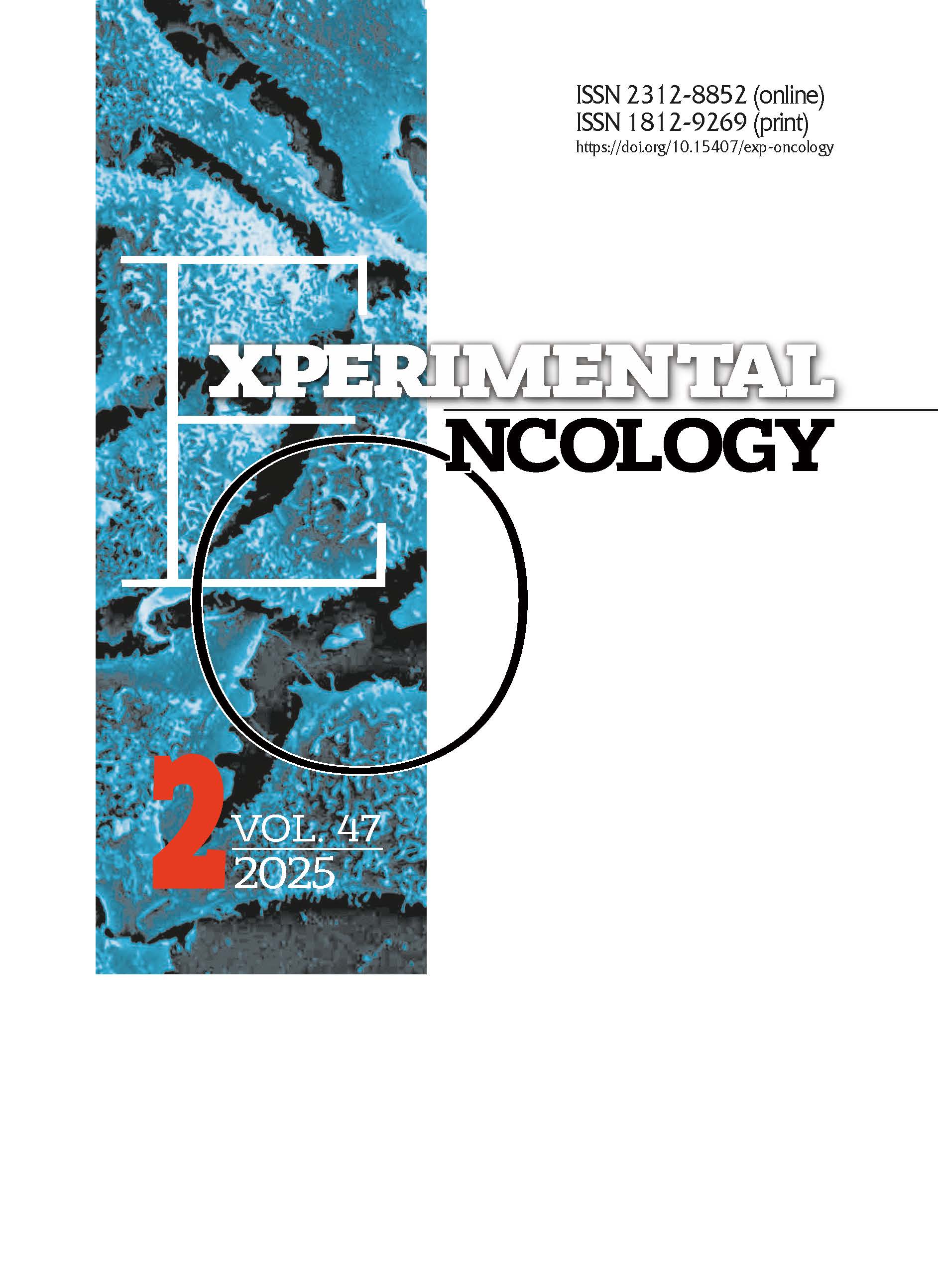CLINICO-MORPHOLOGICAL FEATURES OF THE LUMINAL B SUBTYPE OF BREAST CANCER IN YOUNG WOMEN
DOI:
https://doi.org/10.15407/exp-oncology.2025.02.245Keywords:
breast cancer, young age, Ki-67, luminal subtype, pathological response, neoadjuvant therapyAbstract
Aim. To evaluate the clinical and morphological features of breast cancer (BC) of the luminal B subtype in young women to determine biological aggressiveness, response to neoadjuvant chemotherapy, and prognosis. Materials and Methods. A retrospective study included luminal B subtype BC patients under 40 years of age (n = 108) and over 55 years (n = 101) treated at the National Cancer Institute. All patients received neoadjuvant chemotherapy according to the ddAC-12T regimen. TNM stages, tumor differentiation grade, Ki-67 expression, hormone receptor status, response to the neoadjuvant chemotherapy (NAC) (RECIST 1.1), pathomorphology grade (Miller — Payne), disease-free (DFS) and overall survival (OS) were analyzed. Results. Patients of the younger age group were more likely to have G3 tumors (68% vs. 45%), high Ki-67 levels >35% (72% vs. 50%), and lymph node involvement (71% vs. 59%). The median estrogen receptor expression was 35% in the young patients vs. 65% in the older patients. Complete histological response to NAC was achieved in 26% of the young patients (vs. 9% in the older group). Five-year RFS in the young women was 82.4% vs. 94.1% in the older group. Conclusions. The luminal B subtype of BC in the young women is characterized by the higher proliferative activity, lower hormonal sensitivity, and more frequent lymph node involvement. Despite the response to NAC, this group demonstrates the worse DFS. The results confirm the need for personalized treatment strategies and improved early diagnosis programs in young patients.
References
Yuan M, Zhu Y, Ren Y, et al. Global burden and attributable risk factors of breast cancer in young women: historical trends from 1990 to 2019 and forecasts to 2030 by sociodemographic index regions and countries. J Glob Health. 2024;14:04142. https://doi.org/10.7189/jogh.14.04142
Srikanthan A, Awan AA, McGee S, Rushton M. Young women with breast cancer: The current role of precision oncology. J Pers Med. 2023;13(11):1620. https://doi.org/10.3390/jpm13111620
Nasim Z, Girtain C, Gupta V, et al. Breast cancer incidence and behavior in younger patients: A Study from the surveil- lance, epidemiology and end results database. World J Oncol. 2020;11(3):88-97. https://doi.org/10.14740/wjon1278
Hu X, Myers KS, Oluyemi ET, et al. Presentation and characteristics of breast cancer in young women under age 40. Breast Cancer Res Treat. 2021;186(1):209-217. https://doi.org/10.1007/s10549-020-06000-x
Jain U, Jain B, Fayanju OM, et al. Disparities in timely treatment among young women with breast cancer. Am J Surg. 2022;224(2):811-815. https://doi.org/10.1016/j.amjsurg.2022.01.019
Guay E, Cordeiro E, Roberts A. Young women with breast cancer: chemotherapy or surgery first? An evaluation of time to treatment for invasive breast cancer. Ann Surg Oncol. 2021;29(4):2254-2260. https://doi.org/10.1245/ s10434-021-11102-x
Liu Z, Sahli Z, Wang Y, et al. Young age at diagnosis is associated with worse prognosis in the luminal A breast cancer subtype: a retrospective institutional cohort study. Breast Cancer Res Treat. 2018;172(3):689-702. https://doi. org/10.1007/s10549-018-4950-
Abulkhair O, Omair A, Makanjuola D, et al. Breast cancer in young women: is it different? A single-center retrospec- tive cohort study. Breast Cancer (Auckl). 2024;18:11782234241236382. https://doi.org/10.1177/11782234241236382
Thorne C, Lee AV. Cross talk between estrogen receptor and IGF signaling in normal mammary gland development and breast cancer. Breast Dis. 2003;17:105-114. https://doi.org/10.3233/BD-2003-17110
Saarto T, Rautiainen S, Oksa S, et al. High parity predicts poor outcomes in patients with Luminal B-like (HER2 negative) early breast cancer: a prospective Finnish single-center study. Front Oncol. 2020;10:1800. https://doi. org/10.3389/fonc.2020.01800
Zhan MH, Man HT, Zhao XD, et al. Estrogen receptor-positive breast cancer molecular signatures and therapeutic potentials (Review). Oncol Rep. 2022;48(3):184. https://doi.org/10.3892/or.2022.8345
O’Brien J, Lyons T, Monks J, et al. Alternatively activated macrophages and collagen remodeling character- ize the postpartum involuting mammary gland across species. Am J Pathol. 2010;176(3):1241-1255. https://doi. org/10.2353/ajpath.2010.090735
Lyons TR, O’Brien J, Borges VF, et al. Postpartum mammary gland involution drives progression of ductal carci- noma in situ through collagen and COX-2. Nat Med. 2011;17(9):1109-1115. https://doi.org/10.1038/nm.2416
Wang L, Luo R, Lu Q, et al. Miller–Payne grading and 70-gene signature are associated with prognosis of hormone receptor-positive, human epidermal growth factor receptor 2-negative early-stage breast cancer after neoadjuvant chemotherapy. Front Oncol. 2021;11:735670. https://doi.org/10.3389/fonc.2021.735670
Łukasiewicz S, Czeczelewski M, Forma A, et al. Breast cancer—epidemiology, risk factors, classification, prognos- tic markers, and current treatment strategies—an updated review. Cancers (Basel). 2021;13(17):4287. https://doi. org/10.3390/cancers13174287
Carvalho E, Canberk S, Schmitt F, Vale N. Molecular subtypes and mechanisms of breast cancer: precision medi- cine approaches for targeted therapies. Cancers (Basel). 2025;17(7):1102. https://doi.org/10.3390/cancers17071102
Curtis C, Shah SP, Chin SF, et al. The genomic and transcriptomic architecture of 2,000 breast tumours reveals novel subgroups. Nature. 2012;486(7403):346-352.
Kingston B, Cutts RJ, Bye H, et al. Genomic profile of advanced breast cancer in circulating tumour DNA. Nat Com- mun. 2021;12:2423. https://doi.org/10.1038/s41467-021-24791-5
Lian W, Fu F, Lin Y, et al. The impact of young age for prognosis by subtype in women with early breast cancer. Sci Rep. 2017;7:11625. https://doi.org/10.1038/s41598-017-11819-4
McShane N, Zaborowski A, O’Reilly M, et al. Hormone receptor positive breast cancer in young women: a review. J Surg Oncol. 2025;131(4):580-586. https://doi.org/10.1002/jso.27963
Downloads
Published
How to Cite
Issue
Section
License
Copyright (c) 2025 Experimental Oncology

This work is licensed under a Creative Commons Attribution-NonCommercial-NoDerivatives 4.0 International License.



